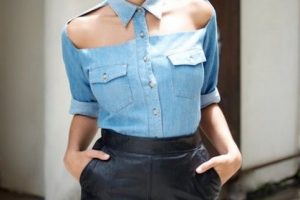
creativecommons.org
Alteration, adjustment or changes in cut, clothing design are united in one word - customization. This concept is rooted far back in history. From the moment people learned to sew, they tried to make every thing as comfortable and beautiful as possible. Clothing customization in our country was especially widespread in the nineties. Suffice it to remember how young people cooked jeans at home and looked for any way to add individuality to faceless outfits that were mass-produced in identical batches.
Every housewife and young mother more than once faces the need to redo something. A simple children's sweater can be turned into a unique one with one application, which will cover a stain made by the child on the clothing. Types of customization include clothing decoration. A black dress on which the owner has embroidered or glued rhinestones is the result of customization. Any accessory sewn or glued to a product changes its original appearance.This means that the clothes no longer convey the designer’s original idea and are considered altered.
What is customization - photos of clothes, types
The concept of customization characterizes the process of transformation, change, reworking of a finished product in accordance with personal views and needs. Customization includes:
- Patchwork technique and products made using the patchwork method.
- The process of creating from one product another thing that has a different purpose, appearance, shape.
- Concealing damage to clothing.
- Adding your own design solutions to new things.
- The process of remaking old things.
There are three common areas of customization in the modern world:
- A person buys clothes in a shopping center or boutique. He independently or by contacting specialists adds decorative elements, changes details of the style or cut. The main goal is product personalization.
- Remaking old things, creating a vintage, non-standard image. To create exclusive outfits, old textures are often used, combining them with modern styles.
- Author's customization. A relatively new direction. It allows the buyer to independently choose the design of the product to his liking. In this case, the clothing will be produced by its direct manufacturer. As a result, the company does not lose the buyer; it sells its product to him. The buyer receives an exclusive item.
Modern customization - photos, non-standard ideas

creativecommons.org
Every designer tries to make the most original things possible. People value exclusive and non-standard solutions in fashion. When altering outfits, a person acts as a personal stylist for himself. That's why the process of creating a new look from existing and worn clothes is so interesting.A few ideas on how to get something new from a boring thing:
- We cut off the sleeves from a boring shirt, add decorative elements, and get a stylish new vest.
- We get rid of the bottom of the dress and get a T-shirt or blouse.
- We shorten the pants to the desired length - new shorts appear.
- An interesting option to transform a denim shirt and a knitted T-shirt is to combine the products. In the area of the shirt pockets, two circles are cut out on the T-shirt and put on top.
- A men's jacket with cut off sleeves and slightly fitted at the sides, this is a great women's vest. If the woman is short and the jacket is long enough, it can be transformed into a dress by adding a belt, a collar decoration and a few buttons.
- Knitted T-shirts are modified with lace inserts, appliqués, and flounces at the bottom or at the armhole.
Bows made of velvet ribbons, satin and lace inserts, decorative pockets, peplum and much more can completely change the appearance of clothing. This is the essence of customization.


 1
1





